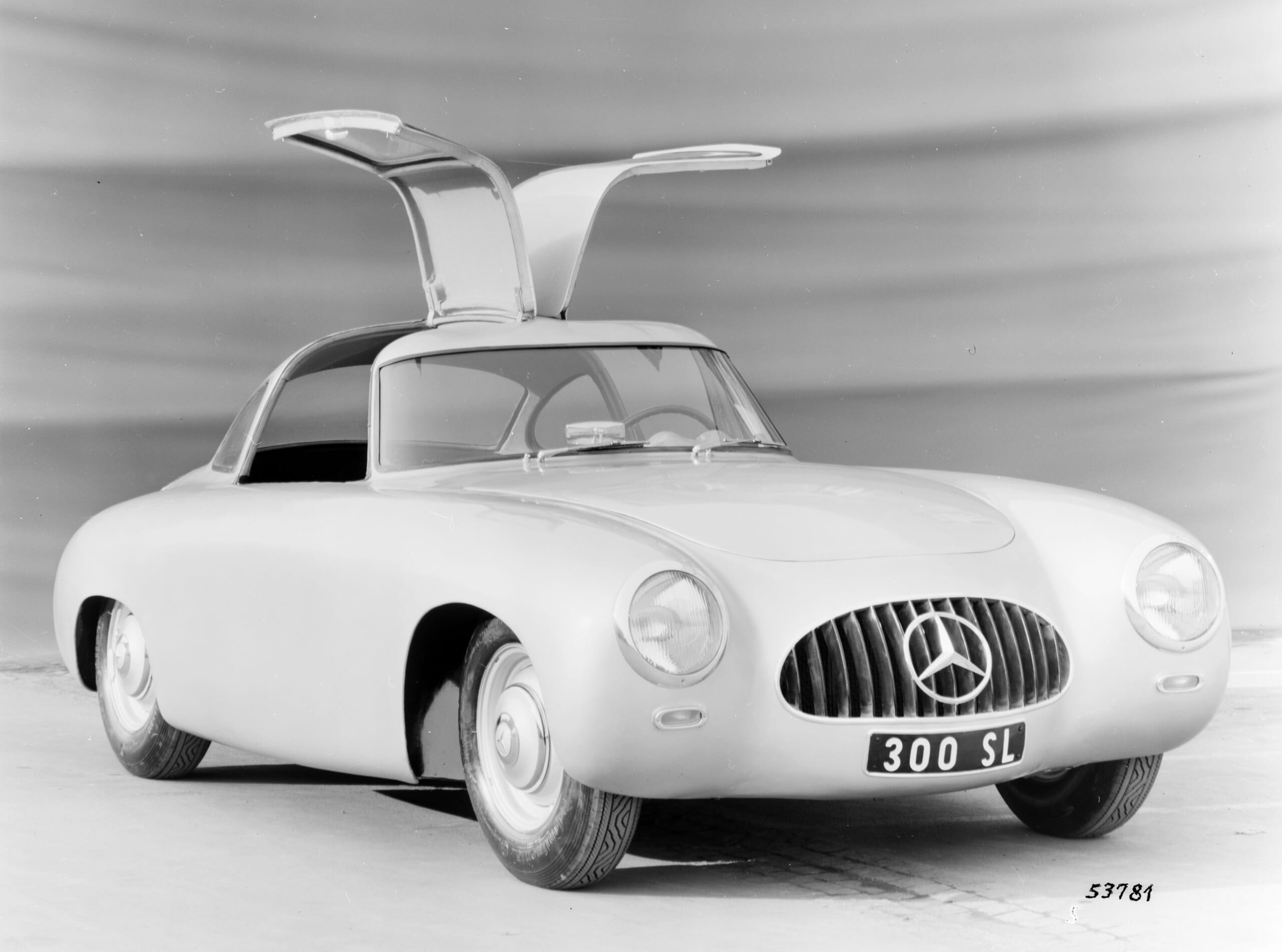Mercedes-Benz, a name synonymous with luxury, performance, and groundbreaking automotive engineering, has a rich history of innovation. Among its many iconic features, the wing door, often referred to as “gullwing door”, stands out as a symbol of avant-garde design and engineering prowess. While sometimes mistakenly attributed to Lamborghini, Mercedes-Benz pioneered this striking door style decades earlier, embedding it into automotive legend.
Let’s explore 8 memorable Mercedes-Benz models that proudly feature these breathtaking wing doors, showcasing a lineage of automotive artistry and ingenuity.
1. 1952 Mercedes-Benz 300SL Racer: The Origin of the Wing Door Mercedes-Benz
The story of the wing door Mercedes-Benz begins in 1952 with the 300SL race car. Necessity is the mother of invention, and for the 300SL, its lightweight tubular space frame design extended high along the car’s sides. This design made conventional doors impractical. Mercedes-Benz engineers ingeniously conceived upward-swinging doors that hinged at the roof, thus giving birth to the iconic wing door and marking the first instance of this design on a Mercedes-Benz vehicle.
2. 1954 Mercedes-Benz 300SL: Bringing Wing Doors to the Road
Two years after its racing debut, the wing door design transitioned from the track to the street with the 1954 Mercedes-Benz 300SL production model. This marked a significant moment, as Mercedes-Benz brought the futuristic and visually stunning wing doors to a commercially available car. The 300SL became an instant classic, celebrated not only for its performance but also for its distinctive and now-iconic wing doors, solidifying “wing door Mercedes-Benz” in the automotive lexicon.
3. 1969 Mercedes-Benz C 111: A Vision of the Future with Wing Doors
Fast forward to 1969, and Mercedes-Benz showcased its innovative spirit once again with the C 111 concept car. This experimental vehicle, part of a series of prototypes, sported wing doors and a striking, futuristic design, typically finished in vibrant safety orange for Mercedes-Benz’s test vehicles. The C 111 pushed boundaries in automotive technology and design, further cementing the wing door as a symbol of Mercedes-Benz’s forward-thinking approach.
4. 1977 Mercedes-Benz C 111 III: High-Speed Wing Door Innovation
The evolution of the C 111 continued with the 1977 Mercedes-Benz C 111 III. This iteration was engineered for high-speed performance and aerodynamic efficiency. Retaining the wing doors, the C 111 III was optimized to achieve record-breaking speeds, demonstrating Mercedes-Benz’s commitment to pushing technological limits while maintaining the visual appeal of its signature door design. It even set a world speed record for diesel engines, highlighting Mercedes-Benz’s diverse engineering capabilities.
5. 1991 Mercedes-Benz C 112: The Supercar That Never Was
In 1991, Mercedes-Benz unveiled the C 112, intended as a successor to the C 111 experimental series and a foray into the supercar market. Equipped with wing doors, the C 112 was designed to elevate Mercedes-Benz’s sporting image as they re-entered motorsport. Despite its advanced technology and striking design, the C 112, unfortunately, never reached production, remaining a tantalizing glimpse of what could have been a wing door Mercedes-Benz supercar.
6. 1997 Mercedes-Benz CLK GTR: A Scissor Door Deviation for Racing Homologation
As Mercedes-Benz re-engaged with motorsports, particularly the 24 Hours of Le Mans, regulations required production car versions of race cars. This led to the creation of the Mercedes-Benz CLK GTR. To meet homologation rules, Mercedes built a limited run of street-legal CLK GTRs. Interestingly, this model opted for scissor doors, reminiscent of Lamborghini designs, rather than traditional wing doors. While not a wing door Mercedes-Benz in the classic sense, it’s included to showcase Mercedes-Benz’s diverse approach to door design in high-performance contexts.
7. 2011 Mercedes-Benz F 125! Research Vehicle: Wing Doors for the Future Sedan
Mercedes-Benz understands the visual appeal of wing doors, often leveraging them to create excitement at auto shows. The 2011 Mercedes-Benz F 125! Research Vehicle concept is a prime example. This concept sedan showcased wing doors to highlight the spaciousness and accessibility of the car’s interior, particularly the rear seats. The F 125! demonstrated how wing doors could be integrated into future sedan designs, making a statement about both luxury and innovation.
8. 2013 Mercedes-Benz SLS AMG: The Modern Wing Door Mercedes-Benz Revival
After a hiatus of several decades, Mercedes-Benz triumphantly reintroduced wing doors to production with the 2013 SLS AMG. This modern marvel paid homage to the original 300SL, reigniting passion for the wing door Mercedes-Benz. The SLS AMG was not just a visual spectacle; it delivered exhilarating performance, becoming an instant classic and a symbol of Mercedes-Benz’s enduring design legacy. Although succeeded by the AMG GT with conventional doors, the SLS AMG leaves enthusiasts hopeful for future wing door Mercedes-Benz models.
A Lasting Wing Door Legacy
From the racetrack to the showroom and concept cars of the future, the wing door Mercedes-Benz has captivated enthusiasts for generations. It represents more than just a unique door mechanism; it embodies Mercedes-Benz’s commitment to innovation, design excellence, and pushing the boundaries of automotive engineering. As we look to the future, the legacy of the wing door Mercedes-Benz serves as a reminder of the brand’s enduring ability to blend groundbreaking technology with breathtaking style.
